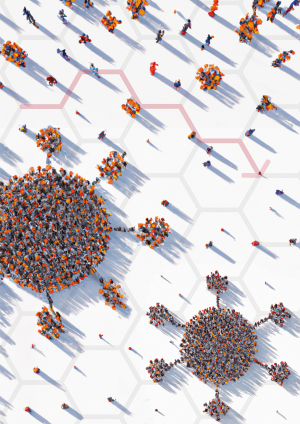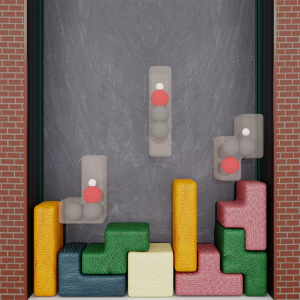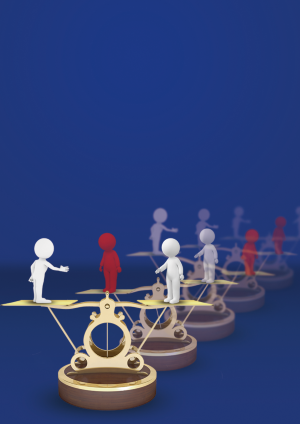Find out more about some of the image submissions from 2022 that almost made it as Nature Computational Science covers.
It’s that time of the year again! We would like to highlight some of our favorite cover suggestions, submitted by authors in 2022, that ultimately were not selected to be featured as issue covers at our journal.

The first image was submitted by Qingtao Cao and Babak Heydari for their Article that proposes a model to study the effect of variations in social interaction structures on different countries’ successes in containing the COVID-19 pandemic. The main idea of the image is to depict how these social microstructures shape the effect of pandemic policies. The light red arrow in the middle divides the image into two different scenarios. Below the arrow, we see the normal, pre-pandemic condition, with close social contacts occurring both locally (within the household or neighborhood, represented by the smaller clusters) and non-locally (with colleagues, friends, and in public spaces, represented by the larger clusters). In this scenario, SARS-CoV-2 is able to easily jump across these clusters. Above the arrow, we see the effects of non-pharmaceutical government policies that aim to reduce close social interactions and make them mostly local (within a cluster or across adjacent clusters).

Another cover runner-up of 2022 was submitted by Mie Andersen and colleagues for their Article on a machine learning-based approach to predict how strongly molecules bind to the surface of potential catalyst materials, an important property for assessing the suitability of these materials before initiating the laborious task of synthesizing them in the laboratory. The image depicts a ‘catalysis Tetris’: just like in Tetris, there are different positions on the surface of a catalyst to which a molecule can bind. The main idea behind the paper is to make the machine learning algorithm learn how to play this Tetris game efficiently.

Finally, Christian Hilbe, Haoxiang Xia and colleagues also submitted an image that turned out to be one of our favorites. The image is an illustration of the method proposed in their Article — a mathematical framework that suggests a strategy based on cumulative reciprocity for sustaining mutual cooperation between individuals — and describes the full history, with different interactions, of the infinitely repeated pairwise prisoner’s dilemma game. The scales represent the key concept behind the proposed method, which enforces fairness in a cumulative manner. The two players’ game actions are represented by the two characters at the opposite sides of the scale for each round of interactions: the white character — who tries to shake hands with the red character — stands for the cooperative action, while the red character stands for the defective action. The scales are slightly tipped to indicate that the cooperator’s strategy gains an advantage over the defector’s one.
Rights and permissions
About this article
Cite this article
Cover runners-up of 2022. Nat Comput Sci 3, 1 (2023). https://doi.org/10.1038/s43588-023-00402-9
Published:
Issue Date:
DOI: https://doi.org/10.1038/s43588-023-00402-9
